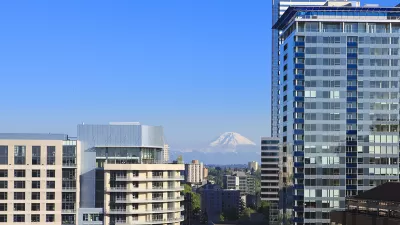Planning scholar Bill Fulton, longtime resident of L.A. and relatively recent transplant to Houston, sizes up the urban implications of a World Series played between two very similar cities.
"When I moved to Houston three years ago – after living in Southern California for thirty years – the thing that struck me more than anything was how similar its urban form is to Los Angeles. An enormous, low-rise city laid out on a grid across a gigantic coastal plane. Glued together by a highly developed freeway system. Punctuated by large job centers scattered across the landscape. Slowly realizing that maybe cars aren’t the answer to everything. And gradually rediscovering the underlying natural environment that gave rise to the city in the first place."
"As I learn more about this moment in Houston’s history, I am struck by the similarities with the Los Angeles I lived in during the late ‘80s and early ‘90s. The emerging world-class traffic problems. (The 610 Loop around The Galleria reminds me so much of the 405 on the Westside.) The dependence on traditional industries that may not be around forever. The struggles of a black-white city accommodating a wide range of emerging ethnicities, especially a fast-growing Hispanic population. The unaffordable housing. The gradual coming to terms with the idea that a world-class city must be urban, not suburban, in nature."
FULL STORY: The World Series of Sun Belt Cities

Planetizen Federal Action Tracker
A weekly monitor of how Trump’s orders and actions are impacting planners and planning in America.

Map: Where Senate Republicans Want to Sell Your Public Lands
For public land advocates, the Senate Republicans’ proposal to sell millions of acres of public land in the West is “the biggest fight of their careers.”

Restaurant Patios Were a Pandemic Win — Why Were They so Hard to Keep?
Social distancing requirements and changes in travel patterns prompted cities to pilot new uses for street and sidewalk space. Then it got complicated.

California Homeless Arrests, Citations Spike After Ruling
An investigation reveals that anti-homeless actions increased up to 500% after Grants Pass v. Johnson — even in cities claiming no policy change.

Albuquerque Route 66 Motels Become Affordable Housing
A $4 million city fund is incentivizing developers to breathe new life into derelict midcentury motels.

DC Area County Eliminates Bus Fares
Montgomery County joins a growing trend of making transit free.
Urban Design for Planners 1: Software Tools
This six-course series explores essential urban design concepts using open source software and equips planners with the tools they need to participate fully in the urban design process.
Planning for Universal Design
Learn the tools for implementing Universal Design in planning regulations.
Heyer Gruel & Associates PA
JM Goldson LLC
Custer County Colorado
City of Camden Redevelopment Agency
City of Astoria
Transportation Research & Education Center (TREC) at Portland State University
Camden Redevelopment Agency
City of Claremont
Municipality of Princeton (NJ)





























